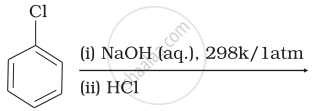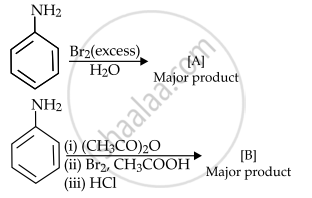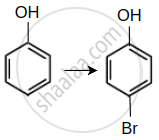Advertisements
Advertisements
प्रश्न
Which of the following reactions will yield phenol?
| (i) |  |
| (ii) |  |
| (iii) |  |
| (iv) |  |
उत्तर
| (i) |  |
| (ii) |  |
| (iii) |  |
Explanation:

Haloarene requires extreme conditions for nucleophilic substitution reaction. Chlorobenzene does not undergo hydrolysis on treatment with aqueous \[\ce{NaOH}\] at 298 K and 1 atm.
APPEARS IN
संबंधित प्रश्न
Write the structures of main products when benzene diazonium chloride (C6 H5 N+2CI−)C6 H5 N2+CI- reacts with the :Cu/HBr
What happens when Phenol is oxidised with Na2Cr2O7/H+?
Why phenol undergoes electrophilic substitution more easily than benzene?
Sodium salt of benzene sulphonic acid on fusion with caustic soda gives ____________.
Which of the following will not form phenol or phenoxide?
Name the catalyst used in the commercial method of preparation of phenol.
In the reaction, alcohol + diazomethane → ether + N2; the ether cannot be ______.

Consider the above reactions, the product A and product B respectively are:
A compound 'X' is acidic and it is soluble in NaOH solution, but insoluble in NaHC0 3 solution. Compound 'X' also gives violet colour with neutral FeCI3 solution. The compound 'X' is:
Match List - I with List - II.
| List I | List II | ||
| (A) |  |
(I) | Br2 in CS2 |
| (B) | (II) | Na2Cr2O7/H2SO4 | |
| (C) |  |
(III) | Zn |
| (D) |  |
(IV) | CHCl3/NaOH |
Choose the correct answer from the options given below:
